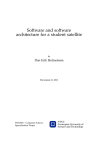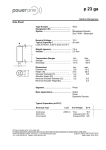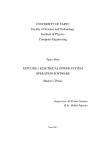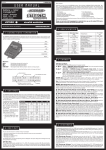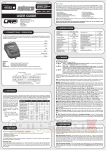Download Electrical Power System (EPS) Role
Transcript
Date : 16/06/2006 Issue : 1 Rev : 0 Page : 1 of 43 Phase A Electrical Power System (EPS) Final report Prepared by: Fabien Jordan Checked by: Approved by: y heig-vd Yverdon Switzerland y 16/06/2006 y Issue : 1 Rev : 0 Date : 16/06/2006 Page : 2 of 43 RECORD OF REVISIONS ISS/REV Date Modifications Created/modified by 1/0 14.06.2006 Initial Issue Fabien Jordan (heig-vd) Ref.: S3-A-EPS-1-0-EPS.doc Issue : 1 Rev : 0 Date : 16/06/2006 Page : 3 of 43 RECORD OF REVISIONS .....................................................................................................................................2 FOREWORD ............................................................................................................................................................4 INTRODUCTION ....................................................................................................................................................5 CUBESAT CONCEPT P-POD INTERFACE LAUNCH VEHICULE SCIENCE MISSION OBJECTIVE ELECTRICAL POWER SYSTEM (EPS) ROLE 1 REFERENCES................................................................................................................................................8 1.1 1.2 2 5 6 6 7 7 NORMATIVE REFERENCES INFORMATIVE REFERENCES 8 8 TERMS, DEFINITIONS AND ABBREVIATED TERMS .........................................................................9 2.1 ABBREVIATED TERMS 2.1.1 Subsystems abbreviations 2.1.2 Technical abbreviations 2.1.3 Definitions 9 9 9 10 3 SEMESTER PROJECT OBJECTIVES .....................................................................................................11 4 EPS DESIGN REQUIREMENTS ...............................................................................................................12 4.1 4.2 4.3 4.4 4.4.1 4.4.2 4.4.3 5 Space environment assumptions Power determination assumptions and approach 14 14 DESIGN TRADES / ANALYSES................................................................................................................15 6.1 ENERGY CAPTURED BY PHOTOVOLTAIC CELLS 6.1.1 Triple junctions cells characteristics 6.1.2 Triple junctions cells degradations 6.1.3 Cells layout 6.1.4 Power calculation : Approach optimistic 6.1.5 Power calculation : Approach pessimistic 6.1.6 Albedo's contribution 6.1.7 Total Energy generated by the solar cells 6.2 MAXIMUM POWER POINT TRACKING (MPPT) EPS ARCHITECTURE 6.2.1 One step-up converter per side 6.2.2 One step-up converter for all sides 6.2.3 Step-up converter 6.2.4 Low-Dropout Linear regulator (LDO) 6.2.5 Common Mode Filters 6.2.6 Batteries 7 12 13 13 13 13 13 13 DESIGN ASSUMPTIONS AND APPROACH ..........................................................................................14 5.1.1 5.1.2 6 PHYSICAL STRUCTURE REQUIREMENTS ELECTRICAL REQUIREMENTS DATA FLOW REQUIREMENTS OTHER SPECIFICATIONS Remove before flight pin Thermal requirements Deployment and Transmission delay 15 15 18 19 20 23 25 25 26 28 28 29 30 32 35 36 CONCLUSIONS ...........................................................................................................................................43 Ref.: S3-A-EPS-1-0-EPS.doc Issue : 1 Rev : 0 Date : 16/06/2006 Page : 4 of 43 FOREWORD SwissCube project aims at designing a picosatellite according to the conventional standard provided by CubeSat. The design and the development of the SwissCube picosatellite will be carried out by students of Swiss Federal Institute of Technology in Lausanne (EPFL) and other Swiss engineer schools and universities. This report was written at the request of the SwissCube project steering committee. Its purpose is to examine and evaluate the different possibilities and to make recommendations concerning the SwissCube Electrical Power System (EPS). The introduction gives a description of the CubeSat concept, the science mission objective and of course the electrical power system role. Chapter 3 enumerates the semester project objectives. Then, chapter 4 describes which requirements are imposed to the EPS design. The assumptions and approach are described in the 5th chapter and finally chapter 6 explains the different trades-off and gives some analysis recommendations. Figure 1 : Example : AAUSAT-1 CubeSat Ref.: S3-A-EPS-1-0-EPS.doc Issue : 1 Rev : 0 Date : 16/06/2006 Page : 5 of 43 INTRODUCTION The SwissCube project is directed by the Space Center at the Swiss Federal Institute of Technology in Lausanne (EPFL). This project is based on the CubeSat program started by Stanford University and Polytechnic State University (Cal Poly) in 1999. CubeSat concept The CubeSat project developed by Cal Poly is an international collaboration of over 40 universities, high schools, and private firms developing picosatellites containing scientific, private, and government payloads. The primary mission of this program is to provide access to space for small payloads. The CubeSat program gives students the opportunity to work in the space technologies field. This opportunity is possible by reducing the cost and development time generally associated with satellite design. To reduce these cost and time constraints it is necessary to drastically reduce the dimensions of the satellite. It is the reason why the fundamental defining feature of the CubeSat standard is its dimensions of 10 x 10 x 10 cm and its mass of no more than 1 kg. Figure 2 : CubeSat standard dimensions [N1] Ref.: S3-A-EPS-1-0-EPS.doc Issue : 1 Rev : 0 Date : 16/06/2006 Page : 6 of 43 P-POD Interface The Poly Picosatellite Orbital Deployer (P-POD) is Cal Poly’s standardized CubeSat deployment system. It is capable of carrying three standard CubeSats and serves as the interface between the CubeSats and LV (Launch Vehicule). The P-POD is an aluminum, rectangular box with a door and a spring mechanism. CubeSats slide along a series of rails during ejection into orbit. CubeSats must be compatible with the P-POD to ensure safety and success of the mission. [N1] Figure 3 : Poly Picosatellite Orbital Deployer (P-POD) Launch Vehicule The SwissCube will be launched by a Vega LV. More information about the Vega LV is given in the VEGA launch vehicule User's Manual. [R1] Figure 4 : Vega LV Ref.: S3-A-EPS-1-0-EPS.doc Issue : 1 Rev : 0 Date : 16/06/2006 Page : 7 of 43 Science Mission Objective The science Payload objective is taking comprehensive measurements of the NightGlow Phenomenon. This luminous phenomenon appears on the earth atmosphere and can be observed by satellite during eclipse because it generates a green luminous glow as shown in Figure 5. The SwissCube will be able to take optical measurements and characterize the Nightglow phenomena over all latitudes and longitudes for at least a period of 3 months. Figure 5 : NigthGlow Phenomena Electrical Power System (EPS) Role The primary EPS function is capturing solar energy from the sun and albedo with solar cells during the daylight and then to transmit it to the subsystems. Given the fact that NightGlow phenomenon can only take measurements during the eclipse SwissCube will have a helios-synchronous orbit in such a way that it will be in eclipse during about 30% of the orbital period. So a part of the captured solar energy must be kept in a battery in order to return it to the subsystems during the eclipse (during this time the solar cells are of course quasi inefficient). The 3 main SwissCube electrical consumers are : - Electrical Power System (converters and linear regulators) - Attitude Control and Determination System (magnetotorquers, motors, …) - Communication System (RF transmitter, …) The payload will take photographs during the eclipse but this work doesn't consume a lot of energy. The secondary EPS function is protecting the different subsystems against a phenomenon called "Single Event Latch-up" (SEL). This phenomenon happens when a high energy particle hits the device. If the impact on the device is of a serious nature, the high energy particle can directly cause damage to the devise. This phenomenon happens very quickly and must be detected and corrected in hardware. In case of the power not being turned off at a latch-up, a burn-out can occur and destroy the chip. Ref.: S3-A-EPS-1-0-EPS.doc Issue : 1 Rev : 0 Date : 16/06/2006 Page : 8 of 43 1 REFERENCES 1.1 Normative references [N1] "CubeSat Design Specification" (CDS), June, 2004. http://littonlab.atl.calpoly.edu/pages/documents/developers.php [N2] RWE Space Solar Power GmbH, Cell Type : RWE3G-ID2/150-8040 1.2 Informative references [R1] VEGA launch vehicule User's Manual, March, 2006. http://www.arianespace.com/site/documents/vega_man_index.html [R2] M. Meusel, "Development status of European multi-junction space solar cells with high radiation hardness", 20th European Photovoltaic Solar Energy Conference, Spain, Barcelona, June, 2005. [R3] G. Strobl, "Advanced GaInP/Ga(In)As/Ge triple junction space solar cells", 3rd World Conference on Photovoltaic Energy Conversion, Osaka, Japan, May, 2003. [R4] ECSS-E-10-04A, "Space environment", January, 2000. [R5] M. Correvon, "Alimentations à découpage à inductance simple", cours de systèmes électroniques, heig-vd, Yverdon, Suisse http://iai.heig-vd.ch/cours.php [R6] VARTA Microbattery, "Sales Program and technical handbook", PoLiFlex, Superior Polymer Technology. Ref.: S3-A-EPS-1-0-EPS.doc Issue : 1 Rev : 0 Date : 16/06/2006 Page : 9 of 43 2 TERMS, DEFINITIONS AND ABBREVIATED TERMS 2.1 Abbreviated terms 2.1.1 Subsystems abbreviations ADCS Attitude Determination and Control System CDMS Control and Data Management System COM Communication System EPS Electrical Power System MECH Mechanisms P/L Payload 2.1.2 Technical abbreviations BOL Beginning Of Life CAN Controller Area Network DOD Depth Of Discharge DnTnS Daylight without transmission and without science DTS Daylight with Transmission and with science EOL End Of Life EnTnS Eclipse without Transmission and without science ETS Eclipse with Transmission and with science GaAs Gallium Arsenide LDO Low-Dropout Linear regulator Li-Ion Lithium-Ion Li-Po Lithium-Polymer LV Launch Vehicle MPPT Maximum Power Point Tracking I 2C Inter-Integrated Circuit PCB Printed Circuit Board PV Photovoltaic SEL Single Event Latch-up TBD To be defined Ref.: S3-A-EPS-1-0-EPS.doc Issue : 1 Rev : 0 Date : 16/06/2006 Page : 10 of 43 2.1.3 Definitions Albedo Albedo is a measure of reflectivity of a surface or body. It is the ratio of total electromagnetic radiation reflected to the total amount incident upon it. The average albedo of Earth is about 30%. Dropout voltage The dropout voltage is the minimum difference between input and output voltage that a LDO needs to do the output voltage regulation. Ref.: S3-A-EPS-1-0-EPS.doc Issue : 1 Rev : 0 Date : 16/06/2006 Page : 11 of 43 3 SEMESTER PROJECT OBJECTIVES The mains objectives of this semester project are collecting information about the space power supply methods and making some preliminary calculations about the power production, the power needs, the dimensions and the mass of the SwissCube Electrical Power System. Finally, the goal is giving several design trade-off with a favorite solution. To fulfill these objectives, the following tasks have to be done : - Read the project documentation (specifications, infrastructure,…), - Read about EPS (other CubeSat papers,…), - Build a Functional Block Diagram of EPS with the other subsystems interfaces, - Build a Hardware Block Diagram, - Build an Architecture, Design and Technology option trees. These different tasks have to be used as tools to correctly develop each subsystem. This working method will help us to think about of a maximum of solutions and configurations. Ref.: S3-A-EPS-1-0-EPS.doc Issue : 1 Rev : 0 Date : 16/06/2006 Page : 12 of 43 4 EPS DESIGN REQUIREMENTS This chapter will enumerate the different design requirements. First, the physical, electrical and data flow requirements will be listed and then we will speak about some other important specifications. 4.1 Physical structure requirements The physical structure requirements for the EPS are principally the mass allocation, the PCB surface and the battery volume. So here are these physical constraints : - Mass allocation : 130 g (given at the Team Meeting 16-03-06) - PCB dimensions : 88 x 98 mm (given by Structure and Configuration subsystem) - Battery volume : 45 x 15 x 90 mm (given by Structure and Configuration subsystem) Batteries (black) EPS PCB (blue) Payload Figure 6 : Batteries and PCB position Ref.: S3-A-EPS-1-0-EPS.doc Issue : 1 Rev : 0 Date : 16/06/2006 Page : 13 of 43 4.2 Electrical requirements No electronics may be active during launch to prevent any electrical of RF interference with the launch vehicle and primary payloads. CubeSats with rechargeable batteries must be fully deactivated during launch or launched with discharged batteries. 4.3 Data Flow requirements ADCS need power information from each side covered by cells. In fact, ADCS will use these power datas to determine the satellite attitude. This is an important constraint that we have to include in our design. 4.4 Other Specifications 4.4.1 Remove before flight pin A remove before flight (RBF) pin is required to deactivate the CubeSats during integration outside the P-POD. The pin will be removed once the CubeSats are placed inside the P-POD. This pin will be directly connected to EPS. 4.4.2 Thermal requirements Operating temperature range is expected to be -40°C to 70°C. 4.4.3 Deployment and Transmission delay To allow adequate separation of CubeSats, antennas may be deployed 15 minutes after ejection from the P-POD (as detected by CubeSat deployment switches). CubeSats may enter low power transmit mode (LPTM) 15 minutes after ejection from the P-POD. LPTM is defined as short, periodic beacons from the CubeSat. CubeSats may activate all primary transmitters, or enter high power transmit mode (HPTM) 30 minutes after ejection from the P-POD. Ref.: S3-A-EPS-1-0-EPS.doc Issue : 1 Rev : 0 Date : 16/06/2006 Page : 14 of 43 5 DESIGN ASSUMPTIONS AND APPROACH This chapter will list the different design assumptions and describe the calculation approach. First, Space environment assumptions will be explained and then the power determination will be described. 5.1.1 Space environment assumptions In a first approach we suppose that insolation and albedo are constant when the satellite is in the sunny area (daylignt). In the shady area (eclipse) we consider that radiations are null. Solar constant (out of atmosphere) : 1368 W/m2 Albedo : 410 W/m2 Insolation period (worst case) : 56.6 min Eclipse period : 36 min Temperature (worst case) : 10 °C (with an altitude of 400 km) The last calculation result obtained by thermal subsystem for the ambient temperature was a range between -23°C and 10°C. When the temperature grows the solar cells efficiency decrease. So the worst case is 10°C. 5.1.2 Power determination assumptions and approach The power that is obtained from solar cell is depended on the angle of incident light. So we assume this generated power is approximated with a cosine of incident light. To determine the power production, two parameters have to be considered : the limit angle of total reflection (when the incident light ray is totally reflected by the cell) and the cell efficiency (which depends on several degradations factors). First, we can consider the best case : - Limit angle of total reflection : 0° - Cells efficiency : 26.6 % (@ 28°C) Then, we can consider the worst case : - Limit angle of total reflection : 20° - Cells efficiency : 20.1 % (@ 28°C) Remark : For the moment, all the power simulations have been made with a temperature of 28°C. In the next step (Phase B) it will be necessary to simulate with the exact temperature range. If the temperature is low that's not a problem but an advantage because the solar cells efficiency is better, so the power results obtained will be necessarily better. Ref.: S3-A-EPS-1-0-EPS.doc Issue : 1 Rev : 0 Date : 16/06/2006 Page : 15 of 43 6 DESIGN TRADES / ANALYSES 6.1 Energy captured by photovoltaic cells Due to increasing requirement for power, mass and area traditional silicon solar cells will be more and more replaced by high efficiency multi-junction solar cells on space solar generators. [R2] Swisscube will certainly be equipped with high efficiency triple junctions cells like this one : Figure 7 : High efficiency triple junction cell (scale 1:1) 6.1.1 Triple junctions cells characteristics GaAs based solar cells have the potential to reach efficiencies greater than 30%. In the meantime cells with up to 28% efficiency are available. [R3] Figure 8 : Triple-junction space solar cell grown on a ultra thin Ge substrate To carry out the electrical power calculation we have initially considered the following cell type : RWE3G-ID2/150-8040 which have an average efficiency of 26.6 % (begin of life). [N2] Ref.: S3-A-EPS-1-0-EPS.doc Issue : 1 Rev : 0 Date : 16/06/2006 Page : 16 of 43 Here are some information about RWE3G-ID2/150-8040 cell type : Design and mechanical data Dimensions : 40 x 80 mm Cell Area : 30.18 cm2 Average Weight : 2.6 g Electrical Data unit BOL* @ 28°C Average Open Circuit Voc [V] 2.554 Average Short Circuit Isc [A] 0.498 Voltage at max. Power Vpmax [V] 2.258 Current at max. Power I pmax [A] 0.480 Maximal Power Pmax [W] 1.083 Average Efficiency η [%] 26.6 *BOL = "Begin Of Life" Temperature Gradients unit BOL dVoc/dT [mV/°C] -6.0 dIsc/dT [mA/°C] 0.272 dVpmax/dT [mV/°C] dPmax/dT -6.4 [mW/°C] 2.72 Ref.: S3-A-EPS-1-0-EPS.doc Issue : 1 Rev : 0 Date : 16/06/2006 Page : 17 of 43 Result of the temperature variations is plotted in Figure 10. The temperature range that we consider is -23 °C to 10 °C. BOL 1E14 2E14 4E14 Voc (T) [V] 3.5 3 2.5 2 1.5 -50 -40 -30 -20 -10 0 10 20 30 40 50 60 70 80 90 100 -40 -30 -20 -10 0 10 20 30 40 50 60 70 80 90 100 -40 -30 -20 -10 0 10 20 30 40 50 60 70 80 90 100 -40 -30 -20 -10 0 10 20 30 40 Temperature [°C] 50 60 70 80 90 100 0.54 Isc (T) [A] 0.52 0.5 0.48 0.46 0.44 -50 Vpmax (T) [V] 3 2.5 2 1.5 -50 Pmax (T) [W] 1.4 1.2 1 0.8 -50 Figure 9 : Temperature effect Ref.: S3-A-EPS-1-0-EPS.doc Issue : 1 Rev : 0 Date : 16/06/2006 Page : 18 of 43 6.1.2 Triple junctions cells degradations Packaging and fabrication losses Mismatch & fabrication 0.98 Wiring & diode loss 0.96 Packing factor 1 Environment issues Temp. loss factor 1.00 Shadowing losses 0.90 Life factors Ultraviolet degradation 0.98 Radiation degradation 0.95 Fatigue (thermal cycling) 0.98 Micrometeoroid loss 0.98 Additional margin 1 The product of all these factors gives the degradations factor. If we multiply the BOL cell efficiency by the degradation factor we obtain the EOL cell efficiency. Degradation factor 0.757 Cell efficiency BOL 26.6 % Cell efficiency EOL 20.1 % Ref.: S3-A-EPS-1-0-EPS.doc Issue : 1 Rev : 0 Date : 16/06/2006 Page : 19 of 43 6.1.3 Cells layout As it has been decided with the other subsystems, SwissCube will have five sides covered by triplejunction solar cells. Each of these five sides is covered by two solar cells : Figure 10 : Two cells per side, on five of the six sides One side must be free for the hole of the camera's objective and for the antenna's fixings : Figure 11 : The camera and antenna side Now, the power generated by the solar cells is calculated with a Matlab Model. Ref.: S3-A-EPS-1-0-EPS.doc Issue : 1 Rev : 0 Date : 16/06/2006 Page : 20 of 43 6.1.4 Power calculation : Approach optimistic To do this calculation, we have supposed that the SwissCube is fixed and a light source is turning around. For the first step of the calculation we consider the vertical plane with an angle alpha : α = 90° α = 0° D α = 180° A F B E C α = 270° 4.5 side A side B side C side D sum 4 3.5 Power [W] 3 2.5 2 1.5 1 0.5 0 0 50 100 150 200 250 300 350 α [°] Figure 12 : Power generated from the insolation (vertical plane) Ref.: S3-A-EPS-1-0-EPS.doc Issue : 1 Rev : 0 Date : 16/06/2006 Page : 21 of 43 Here is the second step (plane of β) : β = 90° β = 0° β = 180° β = 270° D A F B E C 4.5 side D side E side B side F (camera) sum 4 3.5 Power [W] 3 2.5 2 1.5 1 0.5 0 0 50 100 150 200 250 300 350 β [°] Figure 13 : Electrical power generated from the sun (horizontal plane) Ref.: S3-A-EPS-1-0-EPS.doc Issue : 1 Rev : 0 Date : 16/06/2006 Page : 22 of 43 We can now calculate the total power generated whichever the angle β or α we choose : Figure 14 : Total power generated from the sun (best case) This matrix describe the electrical power that can be produce whatever the satellite's attitude, in the best case (limit angle = 0° and efficiency = 26.6%). Maximum value obtained from Matlab is : Pmax = 3.80 W This power peak happen when three sides covered by cells are equally exposed to the sun (for α = 45°, 135°, 225°, 315° and β =125° or 235 °). Average value obtained from Matlab is : Pav = 2.47 W This value is valid under the assumption that all sides are equally exposed to the sun during the mission. Ref.: S3-A-EPS-1-0-EPS.doc Issue : 1 Rev : 0 Date : 16/06/2006 Page : 23 of 43 6.1.5 Power calculation : Approach pessimistic Now, we can do the same calculations for the worst case (limit angle = 20° and efficiency = 20.1%) 3.5 side A side B 3 side C side D sum Power [W] 2.5 2 1.5 1 0.5 0 0 50 100 150 200 250 300 350 α [°] Figure 15 : Power generated from the insolation (vertical plane) 3.5 side D side E side B side F (camera) sum 3 Power [W] 2.5 2 1.5 1 0.5 0 0 50 100 150 200 250 300 350 β [°] Figure 16 : Power generated from the sun (horizontal plane) Ref.: S3-A-EPS-1-0-EPS.doc Issue : 1 Rev : 0 Date : 16/06/2006 Page : 24 of 43 Figure 17 : Total power generated from the sun (worst case) This matrix describe the electrical power that can be produce whatever the satellite's attitude in the worst case (limit angle = 20° and efficiency = 20.1%). Maximum value obtained from Matlab is : Pmax = 2.86 W This power peak happen when three sides covered by cells are equally exposed to the sun (for α = 45°, 135°, 225°, 315° and β =125° or 235 °). Average value obtained from Matlab is : Pav = 1.75 W This value is valid under the assumption that all sides are equally exposed to the sun during the mission. But the satellite's attitude is quite favourable because the side without cells would hardly never be exposed. With the two matrix represented at figure 15 and figure 18 we have calculated an average value with the probable satellite's attitude for the best and worst cases : Assumption : 107° < β < 119° (Inclination given by P/L subsystem : 17 to 29 °) - Best case : Pav = 3.26 [W] - Worst case : Pav = 2.30 [W] For the next developments we will consider the worst case : Pav_sun = 2.30 [W]. Ref.: S3-A-EPS-1-0-EPS.doc Issue : 1 Rev : 0 Date : 16/06/2006 Page : 25 of 43 6.1.6 Albedo's contribution We have used exactly the same approach to determine the albedo's contribution. In fact, albedo can be considered like insolation because waves length are approximately the sames : " A value of 0,3 and the same spectrum as the Sun were specified as standard for the Earth albedo. On a short time scale, albedo can be very variable and range from about 0,05 to 0,6." " The albedo spectrum can change, depending on properties of the surface and atmosphere. Ground vegetation and atmospheric water and dust can lead to absorption in certain wavelength bands and result in a highly variable albedo spectrum." [R4] So Albedo is not constant but we can consider that average albedo is about 30 % of insolation : Albedo = 1368 · 30% = 410 [W/m2]. Assumption : 61° < β < 73° (Inclination given by P/L subsystem : 17 to 29 °) - Best case : Pav = 0.72 [W] - Worst case : Pav = 0.55 [W] For the next developments we will consider the worst case : Pav_albedo = 0.55 [W]. 6.1.7 Total Energy generated by the solar cells Now, we can easily determine the energy potentially captured by photovoltaic cells during one revolution : Insolation period : Tinsolation = 56.6 min Erevol = (Pav_sun + Pav_albedo) · Tinsolation/60 = 2.69 [Wh] Ref.: S3-A-EPS-1-0-EPS.doc Issue : 1 Rev : 0 Date : 16/06/2006 Page : 26 of 43 6.2 Maximum Power Point Tracking (MPPT) All previous results are valid if we can extract the maximum power of each solar cell. But one problem in connecting a solar cell to a load or to a battery is that the cell works at maximum efficiency for only one current and voltage value. In order to use PV cells efficiently we need to know how they behave when connected to various electrical loads. If a PV cell is connected to a variable electrical resistance R, together with an ammeter to measure the current (I) in the circuit and a voltmeter to measure the voltage (V) developed across the cell terminals. When the resistance is infinite the current in the circuit is at its minimum and the voltage across the cell is at its maximum, known as the "open circuit voltage" (Voc). At the other extreme, when the resistance is zero, the cell is in effect "short circuited" and the current in the circuit then reaches its maximum, known as the "short circuit current" (Isc). If we vary the resistance between zero and infinity, the current and voltage will be found to vary as shown in Figure 22, which is known as the "I-V characteristic" of the cell. It can be seen from the graph that the cell will deliver maximum power (i.e. the maximum product of voltage and current) when the external resistance is adjusted so that its value corresponds to the maximum power point (MPP) on the I-V curve. Pmax = V p max ⋅ I p max Figure 18 : I-V characteristic of a typical solar cell Ref.: S3-A-EPS-1-0-EPS.doc Issue : 1 Rev : 0 Date : 16/06/2006 Page : 27 of 43 At lower levels of solar radiation than the maximum the general shape of the I-V characteristic stays the same, but the area under the curve decreases, and the maximum power point moves to the left. The short circuit current is directly proportional to the intensity of solar radiation on the cell, while the open circuit voltage is only weakly dependent on the solar radiation intensity. The open circuit voltage also decreases linearly as cell temperature increases as shown in Figure 10. Power can also be tracked on several parallel cells, even if the intensity of solar radiation differs on each two cells (there are two cells per side) because the MPP of the different cells are approximately on a straight line as shown on Figure 24. But these different MPP can move if the temperature is very different between two sides. So the voltage level is the same for each branch and then several solar cells branches can work together. With this method of global power tracking we can't assure extracting the maximum power of each solar cell but almost. So we will certainly use this method of power tracking for the SwissCube. Figure 19 : Parallel cells with protection diodes Figure 20 : The different MPP are on a straight line Ref.: S3-A-EPS-1-0-EPS.doc Issue : 1 Rev : 0 Date : 16/06/2006 Page : 28 of 43 EPS Architecture 6.2.1 One step-up converter per side Solar cells Step up converter Floating Power Bus 3.7 – 4.2 V Batteries Solar cells Step up converter 3 - 3.3 V Solar cells Solar cells Solar cells Step up converter LDO Filter ACDS LDO Filter CDMS LDO Filter COM LDO Filter P/L LDO Filter Step up converter Step up converter EPS - Power tracking on each side (duty cycles adjustment) - Step-up output current control (duty cycles adjustment) - Battery charge control (duty cycles adjustment) Advantages : - we can extract the maximum power of each solar cell. Disadvantage : - too much heavy (converter's inductances) - require important calculation power - voluminous (converter's inductances) Ref.: S3-A-EPS-1-0-EPS.doc Issue : 1 Rev : 0 Date : 16/06/2006 Page : 29 of 43 6.2.2 One step-up converter for all sides Floating Power Bus Solar cells 3.6 – 4.2 V Step up converter Batteries Solar cells 3 - 3.3 V LDO Filter ACDS LDO Filter CDMS LDO Filter COM LDO Filter P/L LDO Filter Solar cells Solar cells Solar cells EPS - Global power tracking (duty cycle adjustment) - Step-up output current control (duty cycle adjustment) - Battery charge control (duty cycle adjustment) Advantages : - less heavy - less voluminous Disadvantage : - we can't assure extracting the maximum power of each solar cell (but almost !). ADCS need power information from each cells covered side. This is an important constraint that we have to include in our design. The two solutions make it possible. Ref.: S3-A-EPS-1-0-EPS.doc Issue : 1 Rev : 0 Date : 16/06/2006 Page : 30 of 43 6.2.3 Step-up converter The Step-up converter (or Boost converter) uses a parallel static contactor which must be supply by a current source and to output in a voltage source. The receiver itself consists of a resistance R and the filtering capacitor C assembled in parallel to its terminals. This receiver has the behaviour of a voltage source. [R3] Current source Voltage source Figure 21 : Step-up converter Figure 22 : Q : ON and Q : OFF Ref.: S3-A-EPS-1-0-EPS.doc Issue : 1 Rev : 0 Date : 16/06/2006 Page : 31 of 43 Figure 23 : Step-up current and voltage characteristics Ref.: S3-A-EPS-1-0-EPS.doc Issue : 1 Rev : 0 Date : 16/06/2006 Page : 32 of 43 6.2.4 Low-Dropout Linear regulator (LDO) Generally, power supplies give a regulated voltage. It means that the voltage amplitude must vary as little as possible when the output current and the input energy source vary. The voltage amplitude should also not be altered by the temperature variations. The floating Power Bus voltage level is 3.6 to 4.2 Volts. The output voltage level for each subsystem is 3.3 ± 5 % Volts (standard electronic voltage level). Between these two levels, we need a regulator to assure the output voltage specifications. The LDO is an ideal component to do this regulation job. The LDO can also be use by the EPS microcontroller as a switch to enable or disable the different subsystems outputs with a logic signal. This function is very important in case of short circuit on one of the subsystems input. For the moment, we have principally considered the TEXAS INSTRUMENTS LDO's familiy TPS 770xx. This family of LDO offers the benefits of low dropout voltage, ultralow-power operation, and miniaturized packaging. The TPS 770xx family series devices are ideal for micropower operations and where board space is limited. These LDO also have an over current limitation, a thermal protection and an operating junction temperature range of -40 °C to 125 °C. Figure 24 : Functional block diagram and DVB Package The dropout voltage is the minimum voltage that LDO needs to do its regulation between input voltage and output voltage. The TPS 770xx family series devices need only 35 mV of dropout voltage at 50 mA. The regulated output voltage is very accurate. Each LDO will be chosen according to the different subsystems power needs. The mass of one TPS 77001 LDO of this family has been estimated at 2 grams and we need maximum 6 of them. But actually, the architecture is composed of 5 LDO. The 6th may be used to supply the antenna deployment but this point must be defined. For the moment we assume that the antenna deployment is supplied without regulator. But anyway we will use an electronic component to switch on the deployment mechanism. Ref.: S3-A-EPS-1-0-EPS.doc Issue : 1 Rev : 0 Date : 16/06/2006 Page : 33 of 43 Remark : The energy that the antenna deployment requires is very low. It consumes only 2000 mW during 1 second which corresponds to 0.55 mWh only. Beacon 3.3 V COM 3.3 V CDMS 3.3 V PL 3.3 V ADCS 3.3 V (TBD) Solar Cells Figure 25 : Electrical block diagram - LDO layout Here is an output voltage vs output current typical characteristic (TPS 77033) : Figure 26 : Typical LDO load regulation characteristic Ref.: S3-A-EPS-1-0-EPS.doc Issue : 1 Rev : 0 Date : 16/06/2006 Page : 34 of 43 Here is a ripple rejection vs frequency typical characteristic (TPS 77033) : Figure 27 : Typical LDO ripple rejection characteristic The ripple frequency on the input voltage will certainly be included between 50 kHz and 100 kHz. At this frequency the ripple rejection is at worst 27 dB. So if we have an input ripple of 50 mV, the output ripple will be at worst about 2.5 mV. LDO power losses calculation method : LDO power losses depend on the output current and levels difference between input and output voltage. This voltage difference has been estimated at 0.7 Volt on average. The output current has been calculated with the average power consummation of each subsystem. Ploss = Δ V ⋅ I out Δ V = V in − V out I out = Psubsystem V out Ref.: S3-A-EPS-1-0-EPS.doc Issue : 1 Rev : 0 Date : 16/06/2006 Page : 35 of 43 Here are the results for each subsystem : Subsystems Psubsystem [mW] Iout [mA] Ploss [mW] ACDS 550 167 117 EPS (+Beacon) CDMS 100 30 21 40 12 9 COM (RF transmit, receiver and control) 270 82 57 PL 25 8 5 Ploss_tot ≈ 200 mW Figure 28 : LDO power losses results 6.2.5 Common Mode Filters The Common Mode Filter is a passive component. In fact it is simply composed by a circular ferrite and two inductances as shown on figure 36. Figure 29 : Schema of a Common Mode Filter When the output current passes through the first inductance it creates a magnetic field. When the same current come back by the second inductance it generates also a magnetic field but inverse. So the two fields cancel each other out. It is important to place Common Mode Filters on each EPS Power output are. This measure obliges the output current to come back by the same way. This simple device assures that it doesn't have presence of loop currents between the subsystems. Ref.: S3-A-EPS-1-0-EPS.doc Issue : 1 Rev : 0 Date : 16/06/2006 Page : 36 of 43 6.2.6 Batteries A lot of factors must be considered to find the right battery for the SwissCube. But something is sure : the technology choice will be either Li-Ion either Li-Po as shown on figure 33. A : Lithium-Polymer / B : Lithium-Ion / C : Ni-MH / D : Ni-Cd / E : Lead [R6] Figure 30 : Battery technology choice Ref.: S3-A-EPS-1-0-EPS.doc Issue : 1 Rev : 0 Date : 16/06/2006 Page : 37 of 43 1) Nominal Voltage, Vnom and Average Voltage, Vav: The output nominal voltage of two solar cells in series will be about 3.9 V (with a fall voltage of 0.5 V on the protection diode). The output voltage of LDO is 3.3 V. So we decided to use a battery with a typical voltage of 3.6 or 3.7 V (depends on technology Li-Ion or Li-Po). With this choice we don’t unnecessary loose energy to step up the voltage to a higher level like 5 V or more and then to step it down to 3.3 V with the LDO. Actually, we are very interested by a Li-Po technology made by VARTA Microbattery which has a nominal Voltage of 3.7 V. But the average Voltage on the battery terminals will not be 3.7 V because when we charge the battery its terminals voltage increases to 4.2 V. But for the moment we suppose that this level of 4.2 V will never be reached and we assume that the Average Voltage on the battery terminals is 4.0 V. Assumptions : Vnom = 3.7 V Vav = 4.0 V Ref.: S3-A-EPS-1-0-EPS.doc Issue : 1 Rev : 0 Date : 16/06/2006 Page : 38 of 43 2) Accumulated Energy, Eacc : During the daylight the solar cells generate some electrical energy. For the most part, this energy is directly transmitted to the subsystems. But a smaller part of this power production must be kept in the battery in order to return it to the subsystems during the eclipse. Of course the energy accumulated in the batteries must be greater than the amount of energy needed during an eclipse. So we need to know : 1) the amount of energy generated by the cells : Eprod [Wh] 2) the amount of energy needed during the daylight : Eday_needs [Wh] 3) the amount of energy needed during an eclipse : Eecl_needs [Wh] Assumptions (for the worst case) : Eprod = 2.69 Wh (see chapter 6.1.7) Eday_needs = 2.02 Wh (see Power Budget created by System Engineering => DTS) Eecl_needs = 1.19 Wh (see Power Budget created by System Engineering => ETS) Calculation : Eacc = Eprod - Eday_needs = 2.69 – 2.02 = 0.67 Wh But Eacc must be greater than Eecl_needs . So at least it is necessary to accumulate an amount of energy greater than 1.19 Wh. In these conditions the satellite need at least two more daylights with a minimum consumption (DnTnS and EnTnS) to recharge the batteries. Ref.: S3-A-EPS-1-0-EPS.doc Issue : 1 Rev : 0 Date : 16/06/2006 Page : 39 of 43 3) Capacity, Ctot : The DOD is the percentage of the full capacity of the battery that is used during each charge/discharge cycle. The satellite lifetime depends on the batteries lifetime and the batteries lifetime depends on the chosen DOD. So it is necessary to choose a correct DOD. The DOD can be chosen according to the number of charge/discharge cycles. As it is required, the mission will last at least 3 months, but we would like to be operational during one year. On a helio-synchronous orbit, the satellite will turn 15 times around the Earth in one day. For ones year, it will do 5475 revolutions. According to the literature, we should choose a DOD of 30 % for this number of cycles. So we need to know : 4) the Accumulated Energy : Eacc [Wh] 5) the Depth Of Discharge : DOD [%] 6) the average Voltage on the battery terminals : Vav [V] 7) the ambient temperature : Tamb [°C] Assumptions (for the worst case) : Eacc = 0.67 Wh DOD = 30% (see the SMAD) Vav = 4.0 V Calculation : C = (Eacc/Vav) · (1/DOD) = (0.67/4.0) · (1/0.30) = 0.56 Ah If a Li-Po technology is used it is important to consider the ambient temperature. For example, the KOKAM Li-Po manufacturer declares that we can consider the capacity about half reduced if the temperature decreases to -30 °C. Given the fact that the temperature can decrease until -23°C we decide to double the total capacity. Ctot = 2 · 0.56 = 1.12 Ah Ref.: S3-A-EPS-1-0-EPS.doc Issue : 1 Rev : 0 Date : 16/06/2006 Page : 40 of 43 4) Dimensions The structure and configuration group give us the available battery volume : 45 x 15 x 90 mm. The batteries have been chosen according to these dimensions and according to the last constraints. The Li-Po battery technology made by VARTA Microbattery is an interesting solution. They are specialized in Microbattery and their products dimensions and weight are really appropriated for the SwissCube constraints. The PoLiFlex product range contains an integrated thermal and over current protection. Figure 31 : Typical VARTA Li-Po battery with thermal and over current protection The most interesting PoLiFlex model for our application is PLF 443450 C : Nominal Voltage : 3.7 V Typical Capacity : 800 mAh Minimum Capacity : 770 mAh Length (l) : 49.2 mm Width (w) : 34 mm Height (h) : 4.4 mm Pouch (a) : 44.2 mm Weigth : 14 g We have also considered some others battery manufacturers like KOKAM (Li-Po), Sanyo (Li-Ion), Danionics (Li-Ion), etc. But the dimensions were not very appropriate. Ref.: S3-A-EPS-1-0-EPS.doc Issue : 1 Rev : 0 Date : 16/06/2006 Page : 41 of 43 5) Redundancy In order to have a redundancy it is better to take two battery cells than one. If we use two PLF 443450 C Batteries the total capacity is 1.6 Ah and the total mass is 28 g. This is a good compromise. 6) Mass, mbattery : The first EPS mass allocation was 130 g (all inclusive). But we rapidly realized that this allocation was not enough because the batteries are relatively heavy. Here is the actual EPS mass budget : Mass EPS board Battery Step up converter Common mode filter LDO Controller PCB Latchup protection Bus transciever Beacon switch Battery temperature sensor Service connector Battery current sensor Battery voltage sensor Battery smart monitor Voltage sensors (ADCS, PL, COM, CDMS) Current sensors (ADCS, PL, COM, CDMS) S / A Power sensors connector 14 10 5 2 10 30 1 2 1 1 5 1 1 4 1 1 1 4 Nbr 2 1 5 5 1 1 1 1 1 1 1 1 1 1 4 4 5 1 Total 146 28 10 25 10 10 30 1 2 1 1 5 1 1 4 4 4 5 4 The batteries mass represent about a fifth of the total EPS mass budget. Ref.: S3-A-EPS-1-0-EPS.doc Issue : 1 Rev : 0 Date : 16/06/2006 Page : 42 of 43 7) Charging Characteristics To do a correct charge it is necessary to respect a few parameters : - Fast charging can be achieved in a temperature range of 0…+45 °C. - Current of charging needs to be limited to the 1C rate max (a 0.8 Ah battery can be charge with 0.8 A max) - The charging voltage has to be limited strictly with 4.2 V per battery cell in a narrow tolerance of 50 mV. - It recommended terminating the charging either after 3 hrs and/or after the charging current falls below 0.02C. The charging process is illustrated below showing current and voltage of a VARTA PoLiFlex cell using the 1C I-V charging : Figure 32 : Typical PoLiFlex Li-Po Battery Charging Characteristics Due to their low impedance this batteries are also capable of providing very high levels of current. Ref.: S3-A-EPS-1-0-EPS.doc Issue : 1 Rev : 0 Date : 16/06/2006 Page : 43 of 43 7 CONCLUSIONS A lot of work and not enough time… But very very interesting ! Ref.: S3-A-EPS-1-0-EPS.doc













































